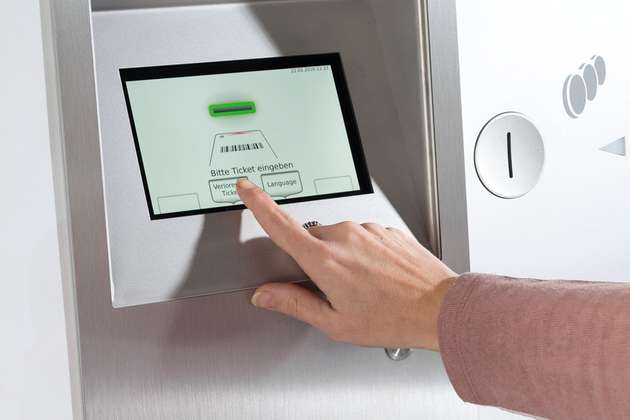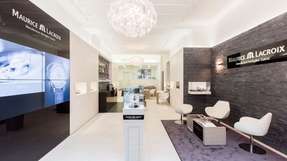In the process of implementing these requirements, the Hamburg-based company Garz & Fricke supplies the automated systems manufacturer Bebarmatic with reliable display solutions and embedded systems – increasingly connected with digital spheres. The Duisburg firm Bebarmatic specializes in parking systems. Especially the requisite vending machines are part of a driver’s everyday life. And every driver knows how annoying it is when the machine fails and you have to dash miles through the pouring rain to find the next one. This is why reliability is one of the absolute musts in vending machine technology.
„Our systems have to be able to withstand not only damp and warmth but also extreme cold,“ says Bebarmatic’s Elmar Schulte-Herweling. “Especially the highly-sensitive touchscreen is a real challenge.“ The touch display has to surmount several difficulties at once. It is open to the elements and has to be suitably robust whilst still being easy to read and sensitive to all inputs.
At first glance, you might think a thick pane of glass would do the job, but it is not as easy as that. ‘Thick panes’ and ‘on-target operation’ are uneasy bedfellows because the light gets refracted in thick glass. This so-called parallax means that it is harder for the user to hit the various operating elements on the screen. Moreover, sensitivity suffers when the pane is thicker. Garz & Fricke can deliver the optimum compromise in various different price categories in accordance with requirements.
Addressing the challenges
Both in terms of price and technical specifications there are significant differences between the screens on offer, so that firms like Bebarmatic can weight and select both aspects in line with intended applications and budgets. Apart from temperature stability and brightness, the potential angle singles out a screen for certain applications. Modern IPS monitors have a wide viewing angle whilst TN displays tend to require direct viewing; they are, however, less expensive. According to engineer and CEO Manfred Garz, there are ways of changing the angle positively but this usually has a negative impact on other features like maximum brightness and picture quality. „With the really expensive displays you can achieve any application you want. But this soon drives the price out of the budget range earmarked for the entire purchase.“
An especially important aspect is screen brightness. Particularly outdoors, simple displays soon reach their limits. Provided the budget is high enough, the user might just as well go straight for monitors using IPS technology, which does, however, force up the price significantly. A less costly option is to employ alternatives such as screens set on a special base under the actual imaging level that reflects the sunlight and generates greater brightness overall. These, however, have the disadvantage that the image shown can seem rather metallic and the colors may lose
some of their intensity.
Resistive or capacitive
In addition to the display technology, customers can also make choices about ‘touch’. The touch-sensitive surface either functions on the principle of a resistive or a capacitive touchscreen. As a rule, resistive technology has the advantage that it is optically more attractive, can easily be operated with gloves on, and is not susceptible to electromagnetic interference. The high level of brightness also speaks in its favor. Monitors of this kind are, however, very susceptible to damage by vandals. Even a simple cigarette lighter can easily damage the plastic surface. And somewhat poorer light transmission and readability in sunlight also speak against resistive touchscreens in carparks. The capacitive touchscreen, by contrast, is positively finger-friendly and yet very robust.
It is designed for input with a bare finger and even recognizes the input of several fingers at the same time – known as multi-touch – for example, gestures. When a finger touches a capacitive touch surface, low currents flow which enable the electronics to determine the position of one or more fingers. Capacitive technology does, however, present developers with some knotty problems, especially outdoors. Unlike the resistive touch, input here can be disrupted by rain drops because in terms of functionality, a droplet of water has the same effect on the screen as a finger – both control the current. Without additional measures, the system cannot tell them apart.
Drops of water on the surface of the screen have a particularly disturbing effect on multi-touch displays. Developers have found a number of tricks to avoid the problem on the software level: The driver software, for example, classifies static or only minimally moving signals as non-fingers and removes the interfering signal sent by the drop. Only when the screen control recognizes that something on the surface is moving intentionally will it translate the signal into input. In developing the firmware, Garz & Fricke cooperate closely with the manufacturers of the touch controller. The fine tuning, specifically with regard to the mechanical construction and the thickness of the cover glass, then takes place back in Hamburg.
As noted above, strong solar radiation poses a second major challenge to developers: temperature. The brighter the environment, the brighter the screen needs to be. Under such conditions, it gives off more heat than when brightness is dimmed. On top of this comes the warming caused by the sun itself.
Scorching heat
The temperature in a parking meter or ticketing machine can soon top 60 °C – an acid test for the built-in electronics which heat up intensively under these conditions, reaching 70 °C or even 80 °C. One of the ways automated systems manufacturers like Bebarmatic solve the problem is by adding a tailor-made system to the machine involving passive and active cooling and targeted air circulation that partially cool the electronics in the embedded systems and the screen.
Engineers at Garz & Fricke also optimize their products with regard to heat radiation and heat resistance by lowering the computing speed of the embedded systems or dimming the displays. In addition, engineers cool the critical components that have a high level of power consumption, such as CPUs and dynamic RAMs, with custom-built, individually-tailored cooling elements made of aluminum injection molding. The heat build-up is then routed into the cooling element and the waste heat is channelled out of the casing. On top of this, screens are thermally isolated and channel part of the waste heat into the touchscreen cover glass.
Low power consumption
Another aspect of optimizing components relates to power requirements. The developers in Hamburg are trying to minimize the power consumption of both the individual components and the system as a whole. After all, less electrical wattage means less waste heat. What is decisive is the low energy requirement for mobile equipment, such as medical devices, for which Garz & Fricke also supply components.
To achieve low levels of power consumption, power-saving RAMs and power management ICs are preferred. In order to minimize power consumption, dynamic RAMs keep the refresh rate to a minimum, at least as long as the temperature remains normal. If the temperature rises, the refresh rate has to be increased to ensure that the volatile memory continues to operate. Components developed in-house automatically adjust the frequency and core voltage of the main processor to the processing power required at any one time. This is known as dynamic voltage and frequency scaling or DVFS, for short. Apart from technically optimizing hard- and software, the developers at Garz & Fricke are increasingly looking to the future of IT. The catchphrase here is ‘the internet of things’ (IoT). For some time now, the Hamburg specialists have been equipping automated systems with communications equipment. Today, more than 30,000 machines boast communication interfaces that are connected to a cloud solution hosted by Garz & Fricke. Operators can use it to check on the condition of their machines and subsequently adjust and optimize issues like planning the routes taken by their service technicians.
Open and competent
So what made Bebarmatic choose Garz & Fricke as a partner? Elmar Schulte-Herweling: „We wanted finished components and we found them at Garz & Fricke. And, on top of this, excellent technical expertise.“ Proprietary solutions are not an option because the Platinum Modular product line is supposed to be flexible and adaptable to the specific wishes of Bebarmatic’s customers. The solution-based approach and good contact to the developers were enough to convince the parking systems manufacturer: „We use our own Linux-based systems and write a lot of our software ourselves. So it was particularly important that the hard- and software interfaces were not only open but very well documented, as well.“ Minimal system failure rates in the barely measurable category convince Elmar Schulte-Herweling time and again that they have chosen the right partner.


















